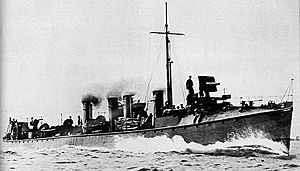HMS Hornet (1893) facts for kids

HMS Hornet
|
|
Quick facts for kids History |
|
|---|---|
| Name | HMS Hornet |
| Builder | Yarrow & Company, Poplar, London |
| Cost | £ 36,112 |
| Laid down | 1 July 1892 |
| Launched | 23 December 1893 |
| Completed | July 1894 |
| Fate | Sold 12 October 1909 for scrapping. |
| General characteristics | |
| Class and type | Havock-class torpedo boat destroyer |
| Displacement |
|
| Length |
|
| Beam | 18 ft 6 in (5.64 m) |
| Draught | 7 ft 6 in (2.29 m) |
| Installed power | 3,700 ihp (2,800 kW) |
| Propulsion |
|
| Speed | 27 kn (50 km/h; 31 mph) |
| Range | 47 tons of coal carried |
| Complement | 46 |
| Armament |
|
HMS Hornet was an early destroyer built for the British Royal Navy. She was launched in 1893 and was later sold for scrap in 1909. While other destroyers were ordered first, Hornet and her sister ship, HMS Havock, were finished faster. This made them the very first destroyers ever built.
Contents
Building the First Destroyers
Designing a New Type of Ship
In 1892, the British Navy wanted new ships to fight against fast torpedo boats. These new ships needed to be quick and carry their own torpedoes and guns. They called them "torpedo boat destroyers," which we now just call destroyers.
The Navy asked several shipbuilders for their ideas. They chose two companies, Yarrow & Company and John I. Thornycroft & Company, to build two ships each. Yarrow built HMS Havock and HMS Hornet.
How Hornet Was Built
Hornet was built at Yarrow's shipyard in Poplar, London. Her construction began on July 1, 1892. She was launched into the water on December 23, 1893, and was fully finished by July 1894.
Hornet was special because she used eight new Yarrow water-tube boilers. These boilers helped her engines make a lot of power. Because of these boilers, she had four tall funnels, which made her look different from her sister ship, Havock, which only had two.
Ship's Weapons and Speed
Hornet was armed with a powerful 12-pounder gun and three smaller 6-pounder guns. She also carried three torpedo tubes. One torpedo tube was fixed in the front (bow) of the ship. The other two were on deck in a special rotating mount. This allowed her to fire torpedoes at enemies on either side.
During her trials, Hornet performed very well. She could reach an average speed of 27.6 knots (51.1 km/h; 31.8 mph) (about 31.7 miles per hour) over a three-hour test. This was very fast for ships of her time!
Service History
Life at Sea
Hornet spent most of her time serving in British waters. She briefly sailed to the Mediterranean Sea in 1900.
Over time, some changes were made to the ship. In 1901, her front (bow) part was made stronger. The torpedo tube at the front of the ship was not very useful and sometimes caused problems. So, by 1902, the two torpedo tubes on her deck were removed. However, Hornet kept her bow torpedo tube.
Later Years and Retirement
In February 1902, Hornet was assigned to help HMS Wildfire at the Sheerness School of Gunnery. She also took part in a special event for King Edward VII on August 16, 1902, called the Coronation Review.
By February 1909, a survey found that Hornet's hull (the main body of the ship) was in poor condition. It would have cost a lot of money to fix her. Because of this, she was sold on October 12, 1909, to be taken apart for scrap metal.

